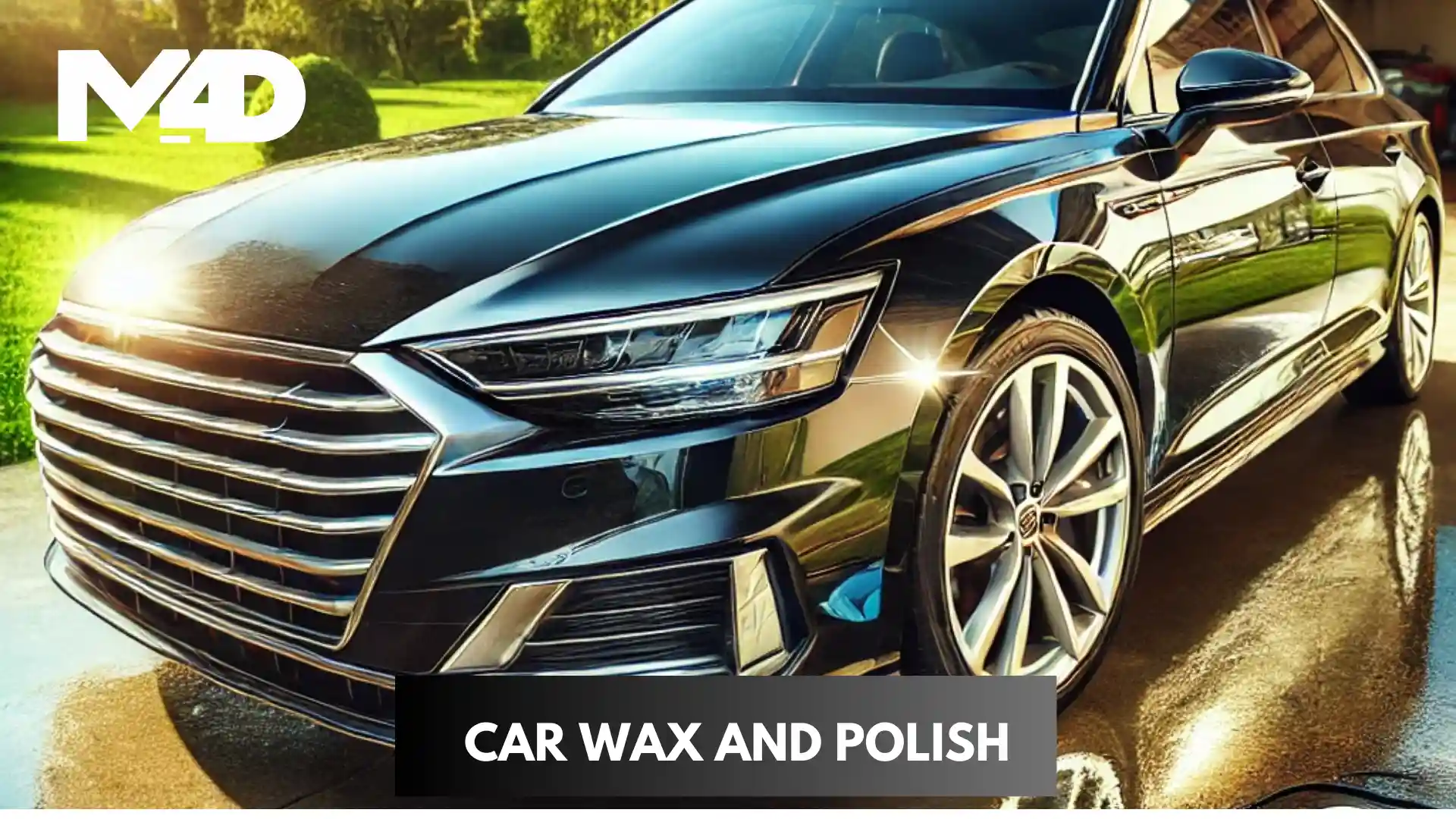The Ultimate Guide to Car Wax and Polish: How to Achieve a Brilliant Shine

Keeping your car in top shape requires more than just regular washes. Waxing and polishing play a crucial role in maintaining your vehicle’s paint job, protecting it from the elements, and keeping it looking brand new. But what’s the difference between the two? How often should you do it? And which products work best? Let’s dive into everything you need to know about car wax and polish to ensure your car has that showroom-worthy shine.
Introduction to Car Wax and Polish
Understanding the Purpose of Car Wax and Polish
Car wax and polish may seem interchangeable, but they serve different purposes. Waxing is about adding a protective layer on top of your car’s paint, shielding it from UV rays, dirt, and grime. Polishing, on the other hand, is focused on improving the paint’s appearance by removing scratches, oxidation, and other imperfections.
The Difference Between Waxing and Polishing
While waxing is the final step that locks in the shine, polishing is what creates that smooth, flawless surface. Wax adds gloss, but polish prepares the surface by smoothing out any rough patches or dull spots.
The Benefits of Waxing and Polishing Your Car
Protecting Your Car’s Paintwork
One of the key benefits of waxing is protection. Car wax creates a barrier that protects your vehicle’s paint from environmental hazards like tree sap, bird droppings, and harmful UV rays. This layer prevents these contaminants from embedding themselves into your paint and causing long-term damage.
Enhancing Your Vehicle’s Appearance
If you want your car to gleam, regular polishing is essential. It removes small scratches, swirl marks, and oxidation that dull your car’s finish, ensuring it looks its best.
Long-Term Maintenance Benefits
Both waxing and polishing contribute to the longevity of your car’s exterior. A well-maintained finish not only looks great but also preserves the value of your vehicle over time.
Types of Car Wax
Natural Carnauba Wax
Carnauba wax, derived from Brazilian palm trees, is a favorite among car enthusiasts for its deep, natural shine. It offers a rich, glossy finish, but it doesn’t last as long as synthetic waxes.
Synthetic Wax
Synthetic waxes are man-made and are designed to last longer than natural waxes. They provide excellent protection against the elements and are ideal for people looking for a low-maintenance solution.
Spray Wax
Spray wax is the easiest and quickest type to apply. While it doesn’t offer as much protection as paste or liquid waxes, it’s a convenient option for touch-ups between major wax jobs.
Types of Car Polish
Cutting Polish
A cutting polish is used to remove more significant imperfections like deep scratches or oxidation. It contains abrasive particles that remove a fine layer of paint, revealing a fresh surface underneath.
Finishing Polish
Finishing polishes are less abrasive and are designed to remove minor imperfections, creating a smooth and glossy surface. This type of polish is often used as the last step before waxing.
All-in-One Polish
All-in-one polishes combine cutting and finishing capabilities in one product, making them convenient for those who want both correction and shine in a single application.
How to Choose the Right Wax and Polish for Your Car
Consider Your Vehicle’s Paint Type
Different paint finishes, such as metallic or matte, may require specific types of wax or polish. Check your car’s manual or consult with a professional to ensure you’re using the right products.
Climate and Weather Considerations
If you live in a region with extreme weather conditions, synthetic waxes may be more effective due to their durability. Natural waxes are better for moderate climates, where frequent waxing isn’t required.
Ease of Application
For beginners, ease of use is key. Spray waxes and all-in-one polishes are simple to apply, while paste wax and cutting polish require more experience and effort to achieve optimal results.
A Step-by-Step Guide to Waxing Your Car
Cleaning and Preparing the Surface
Before you apply any wax, your car should be thoroughly cleaned to remove dirt and debris. Use a clay bar to remove any stubborn contaminants that washing alone can’t eliminate.
Applying the Wax
Once your car is clean, use a foam applicator to apply a thin, even layer of wax in circular motions. Work in small sections, ensuring the wax is evenly spread across the surface.
Buffing for a High-Gloss Finish
Allow the wax to dry to a haze before buffing it off with a clean microfiber cloth. The result? A deep, high-gloss finish that makes your car look like new.
How to Properly Polish Your Car
When to Polish Your Car
Polishing is necessary when your car’s paint looks dull or has visible imperfections. For most cars, polishing once or twice a year is sufficient.
Techniques for Hand Polishing
Hand polishing is labor-intensive but provides a high level of control. Use a foam or microfiber applicator to work the polish into the paint in circular motions, ensuring even coverage.
Machine Polishing Tips
Machine polishing is quicker and more effective for removing significant imperfections. Use a dual-action polisher with the appropriate pads to apply polish evenly without damaging the paint.
Common Mistakes to Avoid While Waxing and Polishing
Over-Polishing the Paint
Over-polishing can thin out your car’s paint and cause damage. Always follow the manufacturer’s guidelines on how often you should polish your car.
Using Too Much Product
A little wax or polish goes a long way. Applying too much can make it harder to buff off and may leave streaks.
Skipping the Surface Preparation Step
Never skip the cleaning process before waxing or polishing. Applying products over a dirty surface will trap contaminants and can even scratch the paint.
Waxing and Polishing Frequency: How Often Should You Do It?
Waxing Frequency
For most cars, waxing every 3 to 4 months is ideal. However, if your car is frequently exposed to harsh weather or pollutants, you may need to wax more often.
Polishing Frequency
Polish less frequently than you wax—typically once or twice a year—to avoid wearing down the paint.
Seasonal Considerations
Many car owners prefer to wax before winter and again in spring to protect their vehicles from winter road salts and summer heat.
Tips for Maintaining the Shine After Waxing and Polishing
Washing Your Car the Right Way
Use a pH-neutral car wash soap to avoid stripping the wax. Always wash with a microfiber mitt to reduce the risk of scratching the paint.
Use of Quick Detailer Sprays
Quick detailers are great for touch-ups between waxes, helping to maintain the shine without the need for a full wax job.
Storing Your Car to Protect the Shine
If possible, store your car in a garage or use a high-quality car cover to protect it from environmental damage and prolong the wax’s lifespan.
Wax vs. Ceramic Coatings: Which One Is Right for You?
What Is Ceramic Coating?
Ceramic coating is a liquid polymer applied to your car’s paint that chemically bonds with the surface, offering long-lasting protection and a glass-like finish.
Key Differences Between Wax and Ceramic Coating
While wax sits on top of the paint, ceramic coating forms a semi-permanent layer. Ceramic coating lasts longer but is more expensive and requires professional installation.
Pros and Cons of Ceramic Coating
Ceramic coatings offer superior protection but come at a higher cost and require more expertise to apply. Waxing, while less durable, is more affordable and can be done at home.
Eco-Friendly Wax and Polish Options
Natural Alternatives to Traditional Wax
Some car waxes are made from eco-friendly ingredients like beeswax or plant-based oils, offering a sustainable option for environmentally conscious car owners.
Biodegradable Polish Formulas
Eco-friendly polishes often use biodegradable materials that minimize environmental harm during manufacturing and application.
DIY vs. Professional Waxing and Polishing: What’s the Best Choice?
The Advantages of DIY Waxing and Polishing
Doing it yourself is cost-effective and gives you full control over the process. Plus, with the right products and techniques, you can achieve professional-looking results.
When to Hire a Professional
For luxury cars or if you’re dealing with significant paint damage, a professional detailer may be the better option. Professionals have the expertise and equipment to handle complex jobs.
Cost Comparison: DIY vs. Professional Services
While DIY waxing and polishing typically cost around $50 to $100 for materials, professional services can range from $150 to $500 depending on the level of service.
Conclusion
Maintaining your car’s exterior with regular waxing and polishing not only enhances its appearance but also protects it from the elements, ensuring it stays in great shape for years to come. Whether you choose to do it yourself or hire a professional, understanding the difference between wax and polish, and knowing how to apply them, will help you achieve a brilliant shine.
FAQs
How long does car wax last?
Car wax typically lasts between 3 to 6 months, depending on environmental factors and the type of wax used.
Can I wax my car too much?
Yes, waxing too frequently can lead to product buildup, making it harder to achieve a smooth finish. Stick to waxing every 3 to 4 months.
Is polishing safe for all types of car paint?
Most car paints can be polished, but certain finishes, like matte, may require specific products to avoid damage.
What’s the best way to remove old wax before applying a new layer?
Use a pre-wax cleaner or clay bar to remove old wax and contaminants, ensuring a clean surface for the new application.
Can I wax and polish my car in direct sunlight?
It’s best to avoid waxing and polishing in direct sunlight, as heat can cause the products to dry too quickly, making them difficult to remove effectively.
The Ultimate Guide to Car Wax and Polish: How to Achieve a Brilliant Shine

Leave a reply
Your email address will not be published.